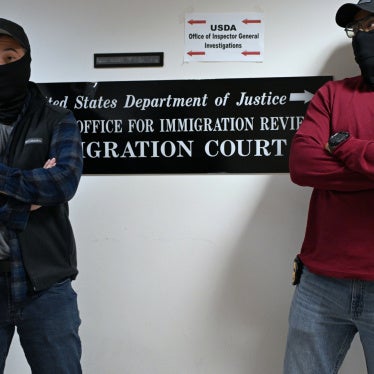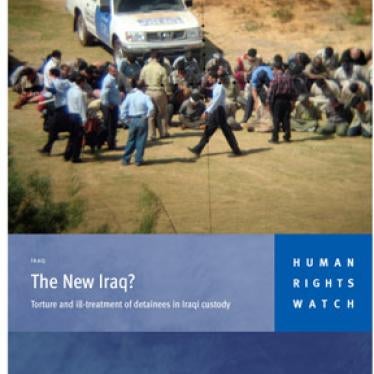On March 3rd, 2015, Human Rights Watch sent this written statement to the Law Enforcement Equipment Working Group, an interagency group which will provide recommendations to President Barack Obama regarding actions that can be taken to improve the provision of Federal support for the acquisition of controlled equipment by law enforcement agencies.
Statement of Human Rights Watch
to the
Law Enforcement Equipment Working Group
March 3, 2015
Human Rights Watch appreciates the opportunity to submit this statement to the Law Enforcement Equipment Working Group.
Human Rights Watch has been concerned over police abuses in the United States for many years. In 1998, we issued Shielded from Justice, a detailed report on the barriers to holding police accountable for abuses or misconduct in 14 large US cities.[1] More recently, Human Rights Watch has issued reports on law enforcement’s failure to test rape kits in Los Angeles and Illinois,[2] and police mishandling of sexual assault complaints in the District of Columbia.[3]
Human Rights Watch researchers recently documented problematic law enforcement practices in Ferguson, Missouri, in the aftermath of the August 2014 fatal shooting of unarmed African-American teenager Michael Brown. Among other concerns, we documented violations of the rights to peaceful assembly and free expression, possible incidents of excessive use of force, and a lack of transparency and accountability in law enforcement’s response to the protests.[4] One feature of the police response was the unnecessarily intimidating use of apparent military weapons and equipment. For example, one protester described seeing police drive up in armored vehicles, full military-style gear, and military assault rifles.[5]
The US Department of Defense’s 1033 program, which allows transfer of surplus federal military equipment to local law enforcement, and its use, should be guided by human rights considerations. As the Working Group considers how to reform the program, it should make four key reforms. An improved program should:
- Ensure that local law enforcement agencies that receive military equipment deploy the equipment only when necessary to deter or respond to likely violence, not to discourage the peaceful exercise of basic rights.
- Require local law enforcement agencies to use the equipment in a proportionate manner in conformity with international law enforcement standards on the use of force;
- Prohibit the transfer of military equipment to law enforcement agencies with a record of human rights violations until there are effective steps toward accountability and redress;
- Allow for a clearly accessible public complaint process about misuse of 1033-related equipment.
Ensure that deploying police with military equipment does not deter people from exercising their basic rights
The rights to peaceful assembly and free expression, in addition to being protected under the US Constitution, are protected under the International Covenant on Civil and Political Rights, which the US ratified in 1992.[6] The covenant not only applies to the federal government, but also to state and local governments.[7] Law enforcement personnel are obligated to protect and uphold those fundamental rights. The use of surplus equipment that could be an appropriate response to a terrorist attack may not be appropriate for responding to a demonstration, even when there is a possibility of violence.
In Ferguson, law enforcement officers often deployed wearing camouflage uniforms and military-style helmets, carrying military weaponry, and traveling in armored vehicles in a seemingly disproportionate response to alleged public safety concerns, discouraging people from demonstrating.[8] A reporter for the Huffington Post reported being confronted by police armed with high-power weapons.[9] During one protest across the street from the Ferguson Police Department, a witness described to Human Rights Watch the arrival of several armored vehicles: “[T]hey had flood lights on us and they had ... about 40 or 50 men and they looked like military gear with M-16s, pointing them directly in our faces and they put the gun in my daughter’s face, telling [us] that we had to get off the property.”[10]
Recommendation
- Prohibit the deployment of 1033-related equipment where the purpose appears to be to deter peaceful assembly and free expression.
Require that use of military equipment comply with international law enforcement standards
The 1033 program should explicitly require that local law enforcement agencies use of any surplus military equipment do so only when necessary and in a proportionate manner, consistent with international law enforcement standards on the use of force. We urge the Working Group to look to the United Nations Code of Conduct for Law Enforcement Officials[11] and the UN Basic Principles on the Use of Force and Firearms by Law Enforcement Officials (the “Basic Principles”).[12] The Basic Principles call for proportionality in law enforcement responses:
Whenever the lawful use of force and firearms is unavoidable, law enforcement officials shall… [e]xercise restraint in such use and act in proportion to the seriousness of the offence and the legitimate objective to be achieved; ...
In the dispersal of assemblies that are unlawful but non-violent, law enforcement officials shall avoid the use of force or, where that is not practicable, shall restrict such force to the minimum extent necessary.[13]
The Executive Order that created the Working Group suggests some of these proportionality concerns. It calls for dissemination of equipment that is “appropriate to the needs of [the] community.”[14] Reforms to the 1033 program should be even more explicit in requiring a commitment to proportionate use.
So that the federal government has accurate information concerning local law enforcement agencies’ use of force, we also urge the Working Group to recommend that transfers be conditioned on the agencies’ cooperation with the Attorney General in the acquisition of data related to the use of excessive force by law enforcement officers, as required under the Violent Crime Control and Law Enforcement Act of 1994.[15]
Recommendations
- Require that law enforcement agencies requesting surplus military equipment commit to proportionate use of such equipment in accordance with international human rights law, and to train its personnel in proportionate use.
- Provide that any surplus military equipment must be recouped if a local law enforcement agency uses such equipment inappropriately, and deny further access to the 1033 programs to local law enforcement agencies with a record of disproportionate use of 1033 equipment.
- Require that local law enforcement agencies cooperate with the Attorney General in data collection on incidents of alleged use of excessive force and prosecutions of law enforcement personnel.
Prohibit transfers to law enforcement agencies with a record of human rights abuses
The Department of Defense should not distribute military equipment to law enforcement units with a record of human rights abuses. The US already applies this principle to foreign military units, prohibiting military assistance if there is credible information that those units have committed gross violations of human rights, such as torture, cruel, inhuman or degrading treatment or punishment, prolonged detention without charge or trial, or other flagrant denials of the right to life, liberty, or security.[16] The State Department vets foreign military units to ensure that they have not committed gross violations of human rights before any security-related funds, training, or equipment are distributed to them. US law does permit remediation, allowing any ban on transfers to be lifted if the foreign government is “taking effective steps to bring the responsible members of the security forces unit to justice.”[17]
Unlike foreign militaries, both the federal government and local law enforcement agencies are ultimately beholden to the US Constitution. However, constitutional requirements in many respects fall short of international standards on use of force. Moreover, local law enforcement agencies have a wildly uneven record when it comes to keeping to obligations both under the Constitution and US obligations under international human rights law. In recent years, several local law enforcement agencies have been responsible for serious police abuses, including torture.[18]
The 1033 program provides substantial assistance to local law enforcement agencies; to allow transfers to continue to agencies that have been credibly implicated in human rights abuses would signal that the federal government at a minimum tolerates those abuses.
Recommendations
- The Department of Defense should prohibit the transfer of surplus military equipment to law enforcement units that have been credibly implicated in human rights violations.
- The Department of Justice should create a vetting mechanism to determine whether a local law enforcement unit seeking surplus military equipment has been credibly implicated in human rights violations.
- The Department of Justice should allow for a lifting of a prohibition under these provisions if the Attorney General determines that effective steps have been taken to bring the individuals responsible for such violations to justice.
Allow for a clearly accessible public complaint process about misuse of surplus military equipment
The misuse of military equipment by local law enforcement has been a long-running concern, most recently brought to wide public attention by protesters in Ferguson.[19] However, the specifics of the 1033 program have not been clear to the public until recently, and little information is readily available concerning specific transfers of equipment to particular law enforcement agencies. In addition, community members who interact with police are best positioned to identify and report potential incidents of excessive or disproportionate police use of force with military equipment. They should have the ability to learn about and comment about potential transfers and to complain about improper use of Defense Department-issued equipment. Therefore, the reformed 1033 program should take the following steps:
Recommendations
- The Defense Department should give notice to the public that a transfer of surplus equipment has been provisionally approved, and give the community an opportunity to comment on the transfer. The provisional approval should be reviewed and potentially delayed or rescinded if community members raise reasonable concerns.
- The Defense Department should create a complaint mechanism so that community members and other observers can report to police on the misuse of such equipment, and allow for a recouping of the equipment by the federal government if community concerns warrant it.
We thank the Working Group for considering these recommendations. We would welcome the opportunity to discuss them at your convenience.
[1] Human Rights Watch, Shielded from Justice: Police Brutality and Accountability in the United States, July 1998, https://www.hrw.org/reports/1998/07/01/shielded-justice.
[2] Human Rights Watch, Testing Justice: The Rape Kit Backlog in Los Angeles City and County, March 2009, https://www.hrw.org/reports/2009/03/31/testing-justice-0. See also Human Rights Watch, “I Used to Think the Law Would Protect Me”: Illinois’s Failure to Test Rape Kits, July 2010, https://www.hrw.org/reports/2010/07/07/i-used-think-law-would-protect-me-0.
[3] Human Rights Watch, Capitol Offense: Police Mishandling of Sexual Assault Cases in the District of Columbia, January 2013, https://www.hrw.org/reports/2013/01/24/capitol-offense-0.
[4] Letter from Human Rights Watch to Missouri Governor Jay Nixon, “Law Enforcement Response to Ferguson Protests,” September 9, 2014, https://www.hrw.org/news/2014/09/09/letter-missouri-governor-jay-nixon-about-law-enforcement-response-ferguson-protests. See also “US: Stop Intimidating Missouri Protesters,” Human Rights Watch news release, August 14, 2014, https://www.hrw.org/news/2014/08/14/us-stop-intimidating-missouri-protesters.
[5] Alba Morales (Human Rights Watch), “Dispatches: On the Ground in Ferguson, Missouri,” August 14, 2014, https://www.hrw.org/news/2014/08/18/dispatches-ground-ferguson-missouri.
[6] International Covenant on Civil and Political Rights (ICCPR), G.A. res. 2200A (XXI), 21 U.N. GAOR Supp. (No. 16) at 52, U.N. Doc. A/6316 (1966), 999 U.N.T.S. 171, entered into force March 23, 1976.
[7] Ibid., art. 50 (“The provisions of the present Covenant shall extend to all parts of federal States without any limitations or exceptions.”)
[8] Paul Szoldra, “Here's A Breakdown Of The Military-Style Gear Used On The Streets Of Ferguson, Missouri,” Business Insider, August 14, 2014, http://www.businessinsider.com/military-gear-police-ferguson-2014-8#ixzz3TLOeGvmE (accessed February 28, 2015),
[9] Ibid.
[10] Human Rights Watch letter to Missouri Governor Jay Nixon.
[11] UN Code of Conduct for Law Enforcement Officials, G.A. res. 34/169, annex, 34 U.N. GAOR Supp. (No. 46) at 186, U.N. Doc. A/34/46 (1979), http://www1.umn.edu/humanrts/instree/i1ccleo.htm (accessed February 28, 2015).
[12] Basic Principles on the Use of Force and Firearms by Law Enforcement Officials, Eighth United Nations Congress on the Prevention of Crime and the Treatment of Offenders, welcomed by UN General Assembly resolution A/RES/45/166, December 18, 1999, http://www.ohchr.org/EN/ProfessionalInterest/Pages/UseOfForceAndFirearms.aspx (accessed February 28, 2015).
[13] Ibid.
[14] Executive Order: Federal Support for Local Law Enforcement Equipment Acquisition, January 16, 2015, http://www.whitehouse.gov/the-press-office/2015/01/16/executive-order-federal-support-local-law-enforcement-equipment-acquisit (accessed February 28, 2015).
[15] 42 US Code 14142 – Data on Use of Excessive Force.
[16] 22 US Code 2304(d)(1).
[17] 22 US Code 2378d(b).
[18] “Jon Burge, Chicago Police Torture and Justice for Survivors,” People’s Law Office, accessed March 2, 2015, http://peopleslawoffice.com/issues-and-cases/chicago-police-torture/. See also UN Committee against Torture, “Concluding observations on the third to fifth periodic reports of United States of America,” CAT/C/USA/CO/3-5, November 20, 2014, http://www.state.gov/documents/organization/234772.pdf (accessed February 25, 2015), para. 26.
[19] Jamelle Bouie, “The Militarization of the Police,” Slate, August 13, 2014, (accessed February 25, 2015), http://www.slate.com/articles/news_and_politics/politics/2014/08/police_in_ferguson_military_weapons_threaten_protesters.html. See also Josh Levs, “Ferguson violence: Critics rip police tactics, use of military equipment,” CNN, August 15, 2014, (accessed February 25, 2015), http://www.cnn.com/2014/08/14/us/missouri-ferguson-police-tactics/,








